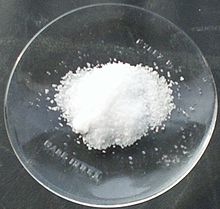
Back Litiumchloried Afrikaans كلوريد الليثيوم Arabic لیتیوم کولورید AZB লিথিয়াম ক্লোরাইড Bengali/Bangla Litij-hlorid BS Clorur de liti Catalan Chlorid lithný Czech Lithiumklorid Danish Lithiumchlorid German Χλωριούχο λίθιο Greek

| |

| |
 | |
| Names | |
|---|---|
| Preferred IUPAC name
Lithium chloride | |
| Systematic IUPAC name
Lithium(1+) chloride | |
| Identifiers | |
3D model (JSmol)
|
|
| ChEBI | |
| ChEMBL | |
| ChemSpider | |
| ECHA InfoCard | 100.028.375 |
| EC Number |
|
| MeSH | Lithium+chloride |
PubChem CID
|
|
| RTECS number |
|
| UNII | |
| UN number | 2056 |
CompTox Dashboard (EPA)
|
|
| |
| |
| Properties | |
| LiCl | |
| Molar mass | 42.39 g·mol−1 |
| Appearance | white solid hygroscopic, sharp |
| Density | 2.068 g/cm3 |
| Melting point | 605–614 °C (1,121–1,137 °F; 878–887 K) |
| Boiling point | 1,382 °C (2,520 °F; 1,655 K) |
| 68.29 g/100 mL (0 °C) 74.48 g/100 mL (10 °C) 84.25 g/100 mL (25 °C) 88.7 g/100 mL (40 °C) 123.44 g/100 mL (100 °C)[1] | |
| Solubility | soluble in hydrazine, methylformamide, butanol, selenium(IV) oxychloride, 1-propanol[1] |
| Solubility in methanol | 45.2 g/100 g (0 °C) 43.8 g/100 g (20 °C) 42.36 g/100 g (25 °C)[2] 44.6 g/100 g (60 °C)[1] |
| Solubility in ethanol | 14.42 g/100 g (0 °C) 24.28 g/100 g (20 °C) 25.1 g/100 g (30 °C) 23.46 g/100 g (60 °C)[2] |
| Solubility in formic acid | 26.6 g/100 g (18 °C) 27.5 g/100 g (25 °C)[1] |
| Solubility in acetone | 1.2 g/100 g (20 °C) 0.83 g/100 g (25 °C) 0.61 g/100 g (50 °C)[1] |
| Solubility in liquid ammonia | 0.54 g/100 g (-34 °C)[1] 3.02 g/100 g (25 °C) |
| Vapor pressure | 1 torr (785 °C) 10 torr (934 °C) 100 torr (1130 °C)[1] |
| −24.3·10−6 cm3/mol | |
Refractive index (nD)
|
1.662 (24 °C) |
| Viscosity | 0.87 cP (807 °C)[1] |
| Structure | |
| Octahedral | |
| Linear (gas) | |
| 7.13 D (gas) | |
| Thermochemistry | |
Heat capacity (C)
|
48.03 J/mol·K[1] |
Std molar
entropy (S⦵298) |
59.31 J/mol·K[1] |
Std enthalpy of
formation (ΔfH⦵298) |
-408.27 kJ/mol[1] |
Gibbs free energy (ΔfG⦵)
|
-384 kJ/mol[1] |
| Pharmacology | |
| V04CX11 (WHO) | |
| Hazards | |
| GHS labelling: | |
 [3] [3]
| |
| Warning | |
| H302, H315, H319, H335[3] | |
| P261, P305+P351+P338[3] | |
| NFPA 704 (fire diamond) | |
| Flash point | Non-flammable |
| Lethal dose or concentration (LD, LC): | |
LD50 (median dose)
|
526 mg/kg (oral, rat)[4] |
| Safety data sheet (SDS) | ICSC 0711 |
| Related compounds | |
Other anions
|
Lithium fluoride Lithium bromide Lithium iodide Lithium astatide |
Other cations
|
Sodium chloride Potassium chloride Rubidium chloride Caesium chloride Francium chloride |
| Supplementary data page | |
| Lithium chloride (data page) | |
Except where otherwise noted, data are given for materials in their standard state (at 25 °C [77 °F], 100 kPa).
| |
Lithium chloride is a chemical compound with the formula LiCl. The salt is a typical ionic compound (with certain covalent characteristics), although the small size of the Li+ ion gives rise to properties not seen for other alkali metal chlorides, such as extraordinary solubility in polar solvents (83.05 g/100 mL of water at 20 °C) and its hygroscopic properties.[5]
- ^ a b c d e f g h i j k l lithium chloride
- ^ a b Seidell, Atherton; Linke, William F. (1952). Solubilities of Inorganic and Organic Compounds. Van Nostrand. Retrieved 2014-06-02.
- ^ a b c Sigma-Aldrich Co., Lithium chloride. Retrieved on 2014-05-09.
- ^ ChemIDplus - 7447-41-8 - KWGKDLIKAYFUFQ-UHFFFAOYSA-M - Lithium chloride - Similar structures search, synonyms, formulas, resource links, and other chemical information
- ^ Cite error: The named reference
Ullmannwas invoked but never defined (see the help page).
© MMXXIII Rich X Search. We shall prevail. All rights reserved. Rich X Search
